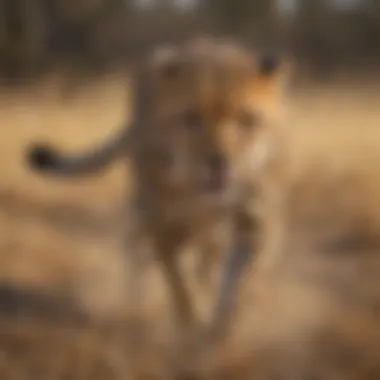Average Cheetah Weight: Insights on Biology and Conservation


Nature Topic Overview
In this article, we will delve into an exciting journey to discover more about cheetahs—particularly focusing on their average weight and its importance to their survival. We’ll explore how these graceful creatures, known for their dizzying speed, adapt to their environments, and how factors like age and gender play a role in determining how much they weigh. Learning about cheetahs isn't just about facts and figures; it's also about understanding their place in the ecosystem and recognizing the challenges they face.
Cheetahs are fascinating members of the big cat family. They weigh differently based on various factors: male and female cheetahs tend to have different average weights. Moreover, their habitats can affect their physical characteristics, including weight. Understanding these differences provides insights into how they survive in their wild homes. As we continue, we'll also highlight how vital understanding these aspects are for conservation efforts aimed at saving these magnificent animals.
Fun Facts and Trivia
Did you know?
- Cheetahs can weigh between 77 to 143 pounds, making them lighter than lions and tigers!
- The fastest land animal, a cheetah can reach speeds up to 60-70 miles per hour in short bursts covering distances up to 1,500 feet.
- Unlike most big cats, cheetahs cannot roar. Instead, they make a variety of vocalizations, including chirps and growls.
This combination of incredible speed and unique weight contributes to their hunting strategy, helping them catch prey most efficiently. They rely not only on their speed but also on their keen eyesight to spot potential meals.
"Cheetahs are designed for speed; their lightweight frame makes fast running possible."
Wildlife Explorations
In the world of wildlife, cheetahs are just one fascinating species. Let’s take a moment to understand some related animals that inhabit similar ecosystems:
- Lions: Known as pride animals, lions weigh notably more than cheetahs, often exceeding 400 pounds, and are social hunters.
- Leopards: These stealthy climbers are around 66 to 176 pounds and adapt well to various habitats, from grasslands to forests.
- Hyenas: Weighing between 90 to 190 pounds, hyenas are skilled scavengers that often compete with cheetahs for their meals.
Such a mix of species contributes to the balance of their habitats, and each plays a distinct role in the ecosystem. Through education and efforts in conservation, we can help protect these animals and their natural settings.
Environmental Awareness
With the beauty of cheetahs and their habitats comes a responsibility to preserve them. Habitat destruction, climate change, and poaching have made it hard for cheetahs to thrive in the wild. By learning about their weight and biology, we can better understand these animals and take action to support their conservation.
Children can help in this effort by:
- Participating in nature walks to learn about local wildlife
- Raising awareness about the importance of conservation through school projects
- Supporting organizations dedicated to wildlife preservation
Even small actions can make a big difference in saving these amazing creatures!
DIY Nature Activities
To foster a love for cheetahs and the natural world, here are some fun, hands-on activities:
- Create a Cheetah Mask: Using cardboard, paints, and creativity, children can make a cheetah mask, learning about the animal’s spots and features.
- Track Learning: Make a simple chart to record local wildlife seen during outdoor adventures. Was it a bird or maybe a deer?
- Story Writing: Encourage kids to write a short story about a day in the life of a cheetah, helping them express their understanding in a fun way.
Outdoor explorations can help children apply what they learn about cheetahs and emphasize the importance of taking care of nature.
By understanding the average weight of cheetahs, we open the door to a broader comprehension of their lives, adaptations, and the crucial steps needed to protect them in a rapidly changing world.
Prelude to Cheetah Weight


Understanding cheetah weight is not just about numbers; it ties directly into their survival, hunting prowess, and overall health. Cheetahs are the fastest land animals, but their speed is intricately linked to how much they weigh and how that weight fluctuates over time. This section sets the stage for exploring multiple dimensions of cheetah weight, emphasizing its biological significance, the unique adaptations of this species, and how it impacts their role within the ecosystem. By examining the average weight and its variations, we can gain insights into the adaptability of cheetahs in their natural habitats.
Overview of Cheetah Species
Cheetahs, known scientifically as Acinonyx jubatus, are a fascinating part of the big cat family. Unlike lions or tigers, they have a slender build, large nostrils for more oxygen intake, and distinctive black tear markings on their faces that help reduce glare from the sun. These adaptations are essentials for a creature that relies on speed to hunt.
Generally speaking, there are five subspecies of cheetahs. One can find them in different regions across Africa, from the open savannas to sparse deserts. Each subspecies has its own unique traits, but they all share a common need for vital nutrition and optimal weight for their habitat.
Significance of Studying Weight
Why does cheetah weight matter? The answer lies in understanding their health and ecology. Weight can serve as a barometer of an animal's well-being. When cheetah populations face stressors like habitat loss or decreased prey availability, their weight tends to fluctuate. This fluctuation can have serious implications, impacting their hunting success and breeding patterns.
Moreover, a cheetah's weight also informs biologists about the availability of resources in their environment. If cheetahs are underweight, it may signal that their habitat is not sustaining them adequately. Conversely, a healthy weight suggests a thriving ecosystem.
"Monitoring weight is essential for effective conservation strategies. Cheetahs, being at the top of the food chain, reflect the health of their entire habitat."
Average Weight of Cheetahs
Understanding the average weight of cheetahs is key to grasping how these animals function, both individually and within their ecosystems. The weight of a cheetah affects its abilities, from hunting prowess to reproduction and overall health. It is not just a number; it's intertwined with the cheetah's lifestyle, habitat adaptability, and evolutionary traits. By delving into a cheetah's weight, we can better appreciate its biological needs and behaviors, as well as the conservation challenges it faces.
Weight Range for Adult Cheetahs
Adult cheetahs typically have a weight range between 77 to 143 pounds (35 to 65 kilograms). This range varies based on several factors including age, sex, and environmental conditions. A general trend shows that male cheetahs tend to be heavier than females. This weight range, though impressive, plays a crucial role in their agility and speed—two essential characteristics for a predator that relies on bursts of speed to hunt.
"Cheetahs, built for speed, must navigate their environment efficiently, and their weight is central to that ability."
There is a notable difference in weight depending on their habitat. Those in open savannahs tend to become slightly heftier due to better access to prey and optimal conditions for growth, while those in more challenging terrains may be a bit lighter. These physical traits underline the fine balance cheetahs maintain in adapting to their surroundings.
Variation Between Males and Females
When examining weight, the disparity between male and female cheetahs becomes evident. Male cheetahs can weigh anywhere from 110 to 143 pounds (50 to 65 kg), while females generally range between 77 to 110 pounds (35 to 50 kg). This difference is not just about size but also about role. Males, being sturdier, often take on the role of protectors when it comes to defending their territory.
Interestingly, a male cheetah’s greater mass can be beneficial during hunting, allowing them to take down larger prey if needed. In contrast, females usually prioritize speed and stealth, essential traits for single-handedly stalking smaller, swifter animals like gazelles. This unique distinction illustrates how weight contributes to gender-specific roles in cheetah populations, affecting group behavior and social structures.
Comparative Analysis with Other Big Cats
When we set cheetahs alongside other big cats, such as lions and tigers, the differences are stark and fascinating. For instance, a lion can weigh between 330 and 500 pounds (150 to 227 kg), while a tiger can weigh even more, ranging from 220 to 660 pounds (100 to 300 kg). In comparison, cheetahs appear slender and are much lighter, emphasizing their unique adaptations for speed rather than brute strength.
In terms of hunting style, lions rely on teamwork and strength, often taking down large prey as a pride. Tigers, being solitary hunters, can take on sizeable opponents, using their larger mass to their advantage. Cheetahs, however, depend on their exceptional speed, allowing them to chase down lighter animals over short distances.
The weight difference between these species underscores the varied strategies employed, giving insights into their ecological niche and behavior. Each big cat, including the cheetah, has adapted its body to suit its hunting and survival needs, further illustrating the intricate balance of nature and the importance of each species within its environment.
Factors Influencing Cheetah Weight
The weight of a cheetah serves as more than just a number; it has substantial implications for its health, hunting capabilities, and overall survival. Understanding the factors that contribute to a cheetah's weight can not only enlighten us about their biology but also help in designing effective conservation strategies. Over the years, various elements have been identified. As we delve into these factors, it's crucial to consider how they interact to shape the existence of cheetahs in their natural habitats.
Age and Developmental Stages


Age plays a significant role in determining the weight of a cheetah. From when they're born to their adult lives, cheetahs undergo notable changes in their body mass.
- Cub Stage (0-3 months): At birth, cheetah cubs typically weigh between 0.5 to 1 kilogram. During this phase, they are entirely dependent on their mothers for nourishment. As they begin to grow, they double their weight in just a few weeks, primarily relying on their mother’s milk.
- Juvenile Stage (3 months - 1 year): They start to eat solid food at about three months old. By the end of their first year, they can weigh somewhere between 20 to 25 kilograms, depending on the availability of food and their overall health.
- Adult Stage (1 year and above): Once they reach adulthood, male cheetahs can weigh between 50 to 60 kilograms, while females typically weigh slightly less, around 35 to 48 kilograms. At this point, their weight is influenced by diet and environmental factors.
"A cheetah's weight is not just a reflection of its age but also a barometer of its health and fitness."
Dietary Considerations
What a cheetah eats directly affects its weight. These big cats are primarily carnivorous, with their diet consisting mostly of small to medium-sized ungulates.
- Prey Availability: In regions where there is an abundance of prey, such as gazelles and impalas, cheetahs tend to maintain a healthy weight. Conversely, a lack of food can cause them to lose weight, which can impair their ability to hunt effectively.
- Nutritional Value: The quality of the prey matters as well. An animal that's lean may not provide sufficient nutrients to support a cheetah’s weight gain. Cheetahs need a balanced diet rich in proteins and fats to thrive.
- Hunting Success: Their ability to effectively hunt also comes into play. Cheetahs are unique in their hunting strategy, relying on speed and agility. A successful hunt boosts a cheetah's weight and overall health, whereas failures can lead to malnutrition and lower weights.
Impact of Habitat and Environment
Cheetahs are adaptable creatures, but their weight can be significantly influenced by their environment.
- Type of Habitat: Cheetahs prefer open savannas and grasslands where they can run at high speeds to catch their prey. Environments that are too dense or bushy may hinder their hunting ability, impacting their food intake and, consequently, their weight.
- Climate Effects: Additionally, extreme weather conditions, like droughts or heavy rains, can influence prey availability in an area, leading to fluctuations in cheetah populations. For instance, if a drought limits food supply, cheetahs may become thinner as they struggle to find sufficient prey.
- Human Interaction: Habitat encroachment by human settlements also disrupts the natural balance. Fragmentation of habitats leads to fewer hunting grounds, which directly affects a cheetah's nutritional intake and weight.
Physiological Implications of Cheetah Weight
Understanding the weight of cheetahs goes beyond just numbers; it touches on their biological functions and how these magnificent creatures have evolved over time. The cheetah's weight plays a key role in its overall physical capabilities, especially when it comes to speed—its most renowned trait. Weight affects not only how quickly they can chase prey but also influences other factors like agility and endurance. An adequate weight allows cheetahs to maintain their status as the fastest land animals. This section aims to unpack the significance of cheetah weight, looking closely at how it connects to their adaptations and muscle structure.
Adaptations for Speed
Cheetahs are built for speed, quite literally. Their lightweight frame, combined with long, sleek bodies, helps minimize drag when they sprint. These cats have unique adaptations, such as:
- Flexible Spine: Their spine acts like a spring, allowing their bodies to stretch out as they run. This flexibility is crucial for increasing stride length.
- Large Nasal Passages: These enable increased oxygen intake during high-speed runs, making sure their muscles get enough oxygen to sustain performance.
- Specialized Claws: Unlike other big cats, cheetahs have claws that aren't fully retractable. This trait provides better grip on the ground.
Imagine how challenging it would be to run so fast if your body was just a bit heavier! If cheetahs were to gain too much weight, it could slow them down, affecting their primary hunting method. As nimble as they are, they must keep their weight within a suitable range to remain effective hunters.
"The faster the chase, the more critical the weight. Every pound can tip the scales of survival."
Muscle Composition and Weight
Now, let’s talk about muscle! In comparison to their body size, cheetahs have a higher proportion of fast-twitch muscle fibers. These fibers are great for explosive strength and swift acceleration. This means cheetahs can sprint faster than any other animal, but it also implies certain constraints regarding their weight.
- Lean Muscles: Their muscular system is lean, which helps maintain their light weight. The muscle-to-fat ratio is vital; too much fat means less agility.
- Energy Efficiency: Since cheetahs rely on short, intense bursts of energy, maintaining an optimal weight is crucial. If they weigh more, they tire out faster during those quick sprints that chase involves.
- Recovery Needs: After a chase, their recovery time also hinges on weight. A lighter cheetah can return to the hunt sooner than a heavier one.
When we look at weight in relation to these physiological factors, it becomes clear that the delicate balance is key. Cheetahs might appear graceful and effortless while running, but their weight—and how their bodies are designed—plays a foundational role in their survival in the wild. Understanding this helps us appreciate how nature fine-tunes these remarkable creatures to be masters of speed.
Cheetah Hunting Strategies
Understanding the hunting strategies of cheetahs sheds light on how their weight affects their predatory efficiency. Cheetahs are known for their remarkable speed and agility, but their weight plays a crucial role in the entire hunting process. By examining specific elements of how weight influences hunting performance and comparing various techniques employed by cheetahs, we can grasp the importance of this aspect in their overall survival.
Role of Weight in Hunting Performance
Cheetahs are built for speed; however, the weight they carry impacts their stamina and dynamics while chasing down prey. Generally, a lighter cheetah may have more agility during quick sprints. This agility helps them maneuver around obstacles and close in on their target effectively. On the other hand, a heavier cheetah might have a burst of power but may not sustain high speeds for as long as its lighter cousin.


Factors such as muscle mass and body fat contribute significantly to a cheetah's overall weight. A muscular build, while beneficial for short bursts of speed, can tire a cheetah more quickly during a chase.
When considering the prey, if it’s larger and more robust, a heavier cheetah might be able to bring it down more efficiently due to greater pushing force. In contrast, during a chase, weight distribution plays a critical role. Being too heavy could hinder a cheetah’s ability to stop abruptly or change directions. This is why finding a balance in weight is vital for these cats; both speed and strategy intertwine, affecting their hunting success.
Comparison of Hunting Techniques
Cheetahs employ different hunting techniques based on their weight and the environment around them. Some of the common methods cheetahs utilize include:
- Solo Hunting: This is typically favored by lighter females who depend on speed to outrun prey. They stalk their target quietly and burst into a sprint when they are within striking distance.
- Group Hunting: Males often hunt in small packs. A greater combined weight and strength can help take down larger prey like wildebeests. In this scenario, teamwork becomes essential, as each cheetah plays a role in corralling the prey.
- Ambush: Cheetahs occasionally take advantage of terrain. For instance, they might hide in tall grass and wait for prey to come close. Here, weight plays a lesser role, and patience paired with surprise contributes to their success.
By examining how weight influences these techniques, it’s evident that both biology and behavior interlink effectively. Each hunting strategy reflects adaptations and choices that align closely with the cheetah’s weight—a relationship pivotal for their survival in the wild.
"In the wild, every gram counts. A cheetah's weight can make the difference between a successful hunt and going hungry."
This connection between weight and hunting methods not only highlights the extraordinary adaptations of cheetahs but also underlines the importance of maintaining healthy weights for the species overall.
Conservation and Cheetah Weight
Understanding the connection between conservation and cheetah weight is critical, not just for the species but for entire ecosystems. Cheetahs, as top predators, have a significant role in maintaining the balance of their habitats. Their weight affects their physical abilities, which in turn influences their hunting success and overall population health. As it stands, a healthy weight is often an indicator of a thriving cheetah.
Importance of Healthy Weight for Populations
Maintaining a healthy weight among cheetah populations has wide-ranging implications. When cheetahs are at their optimal weight, they are more agile, faster, and can hunt efficiently. This is essential for their survival and the survival of their cubs. Here’s why healthy body weight is crucial:
- Survival Rates: Young cheetahs that grow up with access to sufficient food and healthy weight have a better chance of reaching maturity.
- Breeding Success: Adult females with healthy weights are more likely to produce and raise healthy offspring. If a female is underweight, it may not breed at all, which has a direct impact on population numbers.
- Ecosystem Balance: Healthy cheetah weights contribute to effective hunting and prevent overpopulation of prey species, ensuring a balanced ecosystem.
Without healthy weight across populations, cheetahs are at risk. They can struggle to catch prey or compete with other carnivores.
Research in Conservation Efforts
Numerous research efforts focus on how weight affects cheetah conservation. Scientists gather data to understand trends in cheetah weights across various environments and how these trends inform conservation strategies. These studies help in several ways:
- Monitoring Health: Research indicates that tracking the average weight of cheetahs in protected areas can give insights into their overall health. By comparing data from different locations, conservationists can identify areas that may require extra support.
- Feeding Programs: When research shows that certain populations are consistently underweight, feeding programs can be initiated. This aids in providing supplemental food during scarce times, allowing the cheetahs to gain necessary weight to survive and hunt successfully.
- Habitat Preservation: Studies link cheetah weight to habitat quality. If cheetahs are found to be underweight, it may signal that their habitats are degrading. This information is vital for taking measures to restore these environments, ensuring that cheetahs can thrive.
"Understanding the role of weight in elephant cheetah populations offers pathways towards effective conservation strategies"
Epilogue
In this article, we have ventured into the intriguing world of cheetah weight and its broader implications. By understanding average weights, we glean insights into the ecological roles these magnificent animals play, as well as their conservation needs. Weight is not just a number; it speaks volumes about health, adaptability, and survival in a rapidly changing environment.
Summary of Key Insights
The exploration of cheetah weight has revealed several key insights:
- Weight Range: Adult cheetahs typically weigh between 77 to 143 pounds, with males often being heavier than females. This range is essential for understanding their energy requirements and physical capabilities.
- Factors Influencing Weight: Various factors such as age, gender, diet, and habitat affect weight significantly. Younger cheetahs will weigh less than adults, while diet quality directly impacts their overall health and weight.
- Hunting Efficiency: Body weight influences hunting strategies. Lighter cheetahs have faster acceleration and agility, which benefits them while hunting in the wild.
- Conservation Needs: Maintaining a healthy weight is crucial for the survival of cheetah populations. Factors such as habitat loss and prey availability put pressure on their weight and overall well-being.
Future Directions for Research
As research continues to evolve, several important directions emerge:
- Impact of Climate Change: Investigating how shifts in climate patterns affect prey availability and habitats could provide crucial data for conservation strategies.
- Genetic Studies: Focusing on the genetic factors contributing to weight variations may lend insight into breeding programs aimed at enhancing survival rates.
- Longitudinal Studies: Conducting long-term studies on cheetah populations can help to understand weight changes over generations, informing conservation practices.
- Health Monitoring: Developing effective health monitoring systems in the wild helps track changes in weight and health, which can be critical for identifying at-risk populations.
In summary, this article underscores the significance of cheetah weight as a biological, ecological, and conservation-related factor. The key points discussed act as stepping stones for future investigations into this majestic species.







